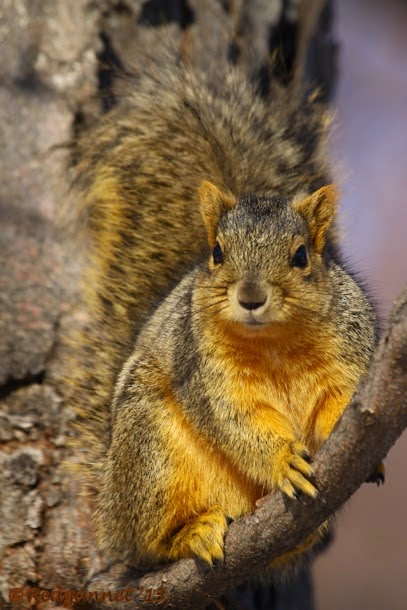A walk in
New York’s Central Park always carries
my hopes for a long list of New World Warblers, but my luck and skill could not
combine to bring these hopes to reality today. It was a glorious day to be out
in the park however and was enhanced by a great look at a young
Red-tailed Hawk and chance meetings
with other like-minded wanderers.
I had borrowed
a bicycle and entered the park on the cross drive at 72
nd St. The
mound that carries a tribute to the Pilgrim Fathers brought some early birds
with the regulation
Blue Jay,
Ruby-crowned Kinglet and the first of
many
Yellow-bellied Sapsuckers.
The Falconer bronze stands beneath an
outcrop of New York Gneiss which harboured
Chipping
Sparrows,
Red-bellied Woodpecker
and
Dark-eyed Junco.
I chained up
the bike by the benches at Wagner’s Cove,
the southern lobe of the boating lake and immediately walked into the red-tail.
It was in a tree which was rooted lower down the bank and this left it sitting
at the perfect height for a picture. It appeared relaxed and I was able to sit
on the rock and enjoy it for a while until a call from another hawk stirred it
into action.
While it
sat, no other birds bothered it, but when it flew, it was chased by Blue Jays
and
American Robins which continued
to bombard it after it landed in a nearby oak.
A second
Red-tail cruised across the cove and my bird gave chase. Mallards on the water ducked beneath the surface each time a hawk
passed over.
A
Pine Warbler was seen in a conifer on
the south side of
Bow Bridge and
raised my hopes of a warbler fest. Another warbler evaded me as I approached
The Oven, but in chasing it, I ran into
Cindy who thought it may have been a
Magnolia
Warbler.
We walked
together for a while and got some good views of Brown Creeper, White-throated
Sparrow and dozens of American Robins along The Spit. We took a slight wrong turn on the way to the feeders
which proved fortunate as an Ovenbird
stepped and flicked through the rank vegetation to the right of the path. Another
warbler by the Azalea Pond had us
foxed, though the smart money is on Tennessee
Warbler.
Cindy left
me here and I continued on to Maintenance
Meadow, arriving at the same time as a party of school kids. It was
dispiriting that the meadow would probably be disturbed, so I moved out quickly
to stay ahead of the children, but was pleasantly impressed as the teacher
primed the class that I was hoping for a quiet few moments and the children
very respectfully gave me that chance.
A
Song Sparrow fed from low plants to the
west of the meadow and a
Cooper’s Hawk
flew high above.
Yellow-bellied Sapsucker and Cedar Waxwings were seen in the large
tree on the northwest corner of the meadow and a Northern Parula gave a poor view and had to be confirmed from a
photograph later on.
Another
birder had seen some warblers up near the arboretum, so I sauntered up that way
and added
Downy Woodpecker, Yellow-rumped Warbler, half-a-dozen more Yellow-bellied Sapsuckers and a
Northern Cardinal.
On the
return south, a Red-breasted Nuthatch
was added from the Shakespeare Garden,
a Blue-headed Vireo was seen from
the Maintenance Meadow and Karen Wang pointed out a Black-throated Blue Warbler near The Gill.
Birds seen;
Canada Goose
(Branta canadensis) 7, Gadwall (Anas strepera) 2, Mallard (Anas platyrhynchos)
15, Northern Shoveler (Anas clypeata) 70, Ruddy Duck (Oxyura jamaicensis) 45, Cooper's
Hawk (Accipiter cooperii) 1, Red-tailed Hawk (Buteo jamaicensis) 5, Ring-billed
Gull (Larus delawarensis) 6, Herring Gull (Larus argentatus) 4, Great
Black-backed Gull (Larus marinus) 3, Mourning Dove (Zenaida macroura) 15, Red-bellied
Woodpecker (Melanerpes carolinus) 8, Yellow-bellied Sapsucker (Sphyrapicus
varius) 10, Downy Woodpecker (Picoides pubescens) 1, Northern Flicker (Colaptes
auratus) 1, Eastern Phoebe (Sayornis phoebe) 1, Blue-headed Vireo (Vireo
solitarius) 1, Blue Jay (Cyanocitta cristata) 25, Black-capped Chickadee (Poecile
atricapillus) 6, Tufted Titmouse (Baeolophus bicolor) 15, Red-breasted Nuthatch
(Sitta canadensis) 1, White-breasted Nuthatch (Sitta carolinensis) 3, Brown
Creeper (Certhia americana) 5, Ruby-crowned Kinglet (Regulus calendula) 6, Hermit
Thrush (Catharus guttatus) 5, American Robin (Turdus migratorius) 120, Gray
Catbird (Dumetella carolinensis) 5, European Starling (Sturnus vulgaris) 15, Cedar Waxwing
(Bombycilla cedrorum) 10, Ovenbird (Seiurus aurocapilla) 1, Northern Parula
(Setophaga americana) 1, Black-throated Blue Warbler (Setophaga caerulescens) 1,
Pine Warbler (Setophaga pinus) 1, Yellow-rumped Warbler (Setophaga coronata) 1,
Eastern Towhee (Pipilo erythrophthalmus) 4, Chipping Sparrow (Spizella
passerina) 30, Song Sparrow (Melospiza melodia) 4, White-throated Sparrow
(Zonotrichia albicollis) 150, Dark-eyed Junco (Junco hyemalis) 6, Northern
Cardinal (Cardinalis cardinalis) 10, Common Grackle (Quiscalus quiscula) 35, House
Finch (Carpodacus mexicanus) 1, American Goldfinch (Spinus tristis) 1, House
Sparrow (Passer domesticus) 80.
Central Park
can be found on Manhattan between 5th and 8th Aves and
from 60th St, north to 110TH St.
The most
talked about area for birding is The
Ramble, which can be seen at Google Earth ref; 40 46 36.89N73 58 10.74W
Previous
posts from New York’s Central Park can be seen at the links below;




































